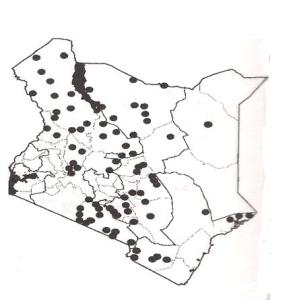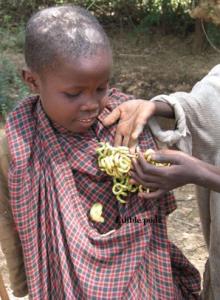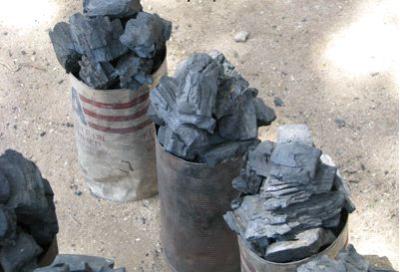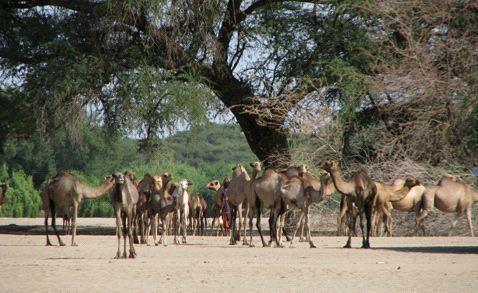Scientific name
Acacia Tortilis
Order / Family
Fabaceae
Local Names
Boran (Dadach, Dadacha); Kamba (Muaa, Mulaa); Kipsigis (Chebitet); Luo (Otiep); Maasai (Oltepesi, Sagararam (fruit)); Marakwet (Ses); Mbeere (Mugaa); Nandi (Sesya); Swahili (Mgunga,Munga); Turkana (Ewoi)
Introduction
General Distribution:
The A. tortilis species is common in most parts of dry Africa from North and West Africa to South Africa. In Kenya, it is an indigenous tree. It's widespread in the lowland arid and semiarid areas of the country.
 |
| Distribution of Acacia tortilis in Kenya |
| © Maundu P. and Bo Tengnas. (2005). Useful trees and shrubs for Kenya, World Agroforestry Centre. |
General Information about the Tree:
A. tortilis is indigenous in Angola, Botswana, Egypt, Eritrea, Ethiopia, Iran, Israel, Kenya, Mozambique, Namibia, Qatar, Saudi Arabia, Somalia, South Africa, Sudan, Swaziland, Tanzania, Uganda, United Arab Emirates, Zambia, Zimbabwe
Biophysical Limits:
It tolerates a wide range of soils ranging from sandy, silty to black-cotton soils. However, it may be dominant on dry red soils and prefers slightly alkaline conditions. It is often found along rivers, in the altitude ranging from 0 to 1,650m above sea level. Capable of growing in shallow soils, it is among the most drought-resistant of the acacias in Kenya; rainfall needs range between 150-900mm per annum. Does well in agro-ecological zones IV-VII.
Propagation and Tree Management
Mixed enrichment/ agroforestry Propagation is by seedlings, wildings, direct sowing at site (seeds taken straight from pod rarely germinate due to seed dormancy), It's slow growing but may grow relatively fast on dry sandy soils if weeding is done and goats are kept away. Also withstands moderate lopping and does not coppice well. Prune when young.
Products:
- Timber; It is even believed that Noah of the Old Testament made his ark from the wood of A. tortilis. Its wood is used for planking, boxes, poles, moisture proof plywood, gun and rifle parts, furniture, house construction and farm implements.
- Medicine; dried powdered bark is used as a disinfectant in healing hounds.
- Fodder; Pods and leaves are used as animal feed especially for goats and camels.
- Poison: it is a strong molluscicide and algicide; its fruits are placed in fish ponds to kill the snail species that carry schistosomiasis, without affecting the fish.
- Fibre: Strings are made from bark.
- Food; The Maasai people eat immature seeds and in turkana pods are used to make porridge after extracting the seed.
- Tannin and dye; the bark is a source of tannin
- Fuel; It is a good source of firewood and high quality charcoal.
- Pins and needles; Its thorns are used as pins or needles.
 |
| Edible products of umbrella thorn acacia |
| © Bo Tengnas |
 |
| Charcoal of umbrealla thorn acacia |
|
© Bo Tengnas
|
Services:
- Erosion control: this tree grows faster and is drought resistant; this makes it more useful in soil conservation, afforesting shifting sand dunes, refractory sites, hill slopes, ravines and lateritic soils.
- Shelter or shade; The Turkana people uses it as a meeting place and also provides shade for both people and animals in hot sun.
- Ornamental
- Nitrogen fixation; A. tortilis has nodules and hence fixes nitrogen in the soil.
- Boundary, barrier or support; its thorny branches are suitable material for erecting barriers.
 |
| Shelter under the tree in hot sun |
| © Bo Tengnas |
Pests and Diseases
In some parts, powder pest beetles (Sinoxylon anale and S. crassum) are serious pests of A. tortilis timber. They can reduce felled timber into dust in a matter of weeks. To avoid these attacks, prophylactic treatment is recommended, with 1.5% lindane 20 EC water emulsion or 1.5% endosulfan 35 EC water emulsion.Other pests are; Callosobruchus chinensis and Caryedon gonogara (bruchid). It is also susceptible to attacks by other beetles, caterpillars and blight.
The pod and seed insects can be controlled by treating specific branches with 0.25% endosulfan or fenitrothion water emulsions.Seeds stored in gunny bags can be dusted with 5% folithion for short-period treatment to prevent them from pest attacks. But if they going to be stored for a longer period, apply 10% BHC should be applied with a duster. You can also fumigate with carbon disulphide, aluminium phosphide or chlorosal to kill seed- and podboring bruchids. Pyrethrum mixed with seed in a seed-dressing drum can also act as an insect repellent.
Information Source Links
- Maundu P. and Bo Tengnas. (2005)Useful trees and shrubs for Kenya, World Agroforestry Centre. ISBN-9966-896-70-8.
- Orwa C, Mutua A , Kindt R , Jamnadass R, Simons A. 2009. Agroforestree Database:a tree reference and selection guide version 4.0
